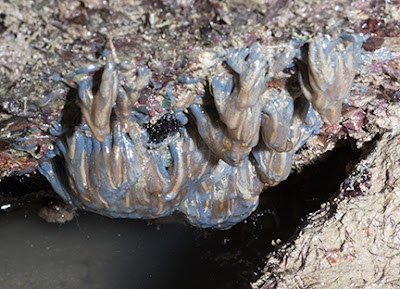We came across seagrasses teeming with marine life, and Knobbly sea stars! My last proper survey here in Apr 2012.
Seringat-Kias was created by reclaiming the submerged reefs of Seringat and Kias. One of the touted features on this island is the C-shaped 1km long artificial lagoon. Here's more about what was done to create Seringat-Kias. There's marine life on the artificial shore as well as on the natural shores of Lazarus Island. Today, I only did the large lagoon.
In the big artificial lagoon, there were lush patches of Spoon seagrass with tiny leaf blades and Needle seagrass with narrow leaf blades. How nice to see Knobbly sea stars among the seagrasses. This large one was among those that Kok Sheng found, including some baby Knobblies. Ian also found a baby Knobbly. I also saw some Common sea stars.
I also came across a small patch (about 2m x 2m) of Smooth ribbon seagrass.
There was even a small clump of Tape seagrass with very long leaf blades. This was was producing several female flowers.
I saw pieces of Noodle seagrass washed up. Perhaps it is growing in deeper water?
Seagrasses allow a thriving variety of small animals to live in the lagoon. Among them were some superbly camouflaged fishes. Like this Feathery filefish!
Often mistaken for a blob is the Spot-tail frogfish!
The frogfish literally lures prey to come closer. The lure is at the top of its head, just above its very large, upward facing mouth.The lure is made up of the first spine of the dorsal fin. The spine is modified into a rod or stalk (called the illicium) tipped with a fleshy, fluffy or otherwise attractive bit (called the esca). This bit is wriggled, jerked and waved about so it appears to be a helpless and tasty little morsel. While the fish itself remains motionless, looking like just another lump of rock or other harmless thing. Unsuspecting creatures that attempt to eat the lure are instead eaten by the frogfish!
Another well camouflaged fish: the White-spotted rabbitfish, commonly seen in our seagrass meadows. There were also many Tropical silversides from tiny ones to medium-sized ones.
There were also many small Bigfin reef squid. These masters of camouflage can rapidly adjust their body pattern to blend in with their surroundings. The seagrasses were dotted with Bazillion snails and I also saw some Dubious nerites. I also saw several Oval moon snails.
There were also many crabs: Spotted moon crabs, tiny to small Flower crabs and other Swimming crabs. And many different kinds of shrimps. On the higher shore, I saw many small Ghost crabs.
I also came across a Spotted orange hermit crab, which I usually see more often near reefs. Also saw no slugs or flatworms.
Kok Sheng found a Fire anemone. I saw only a few Haddon's carpet anemones, and one Pearly sea anemone. I didn't come across any Peachia anemones. We saw some Slender sea pens, but I didn't see any cerianthids.
Mei Lin pointed out there very many Remarkable sea cucumbers in the sandy areas. I saw several skeletons of the rare Thick-edged sand dollar but didn't see any live ones. I also didn't see any living Cake sand dollars. Among the seagrasses I saw one Garlic bread sea cucumber but didn't come across any sea urchins.
The shore is still trashed in some parts, although most of it is quite clean. Although it's a Saturday morning, there were no pleasure craft at the pontoon or anchored in the big lagoon.
There were a lot of single-use cups. Are these the kind that are provided in ferries that travel near this island?
This looks like one of the many mattresses that we had seen at nearby Kusu Island in 2014. Sentosa Development Corporation has been working hard to try to remove as many mattresses as they can.
On the high shore, there were many plastic bottles and styrofoam in many sizes.
There was also this large bag-like thing (about 1m x 1m) filled with some kind of synthetic foam. I don't know what it is.
There's also trash among the lush growths of Needle seagrass.
The low water mark was lined with washed up seaweed.
Most the seaweed looks like this Feathery red seaweed. But there were a wide variety of other seaweeds flourishing among the seagrasses.
The seawall didn't seem to be well covered in corals. I did clumps of these blue Bubble ascidians that so far I've only seen at Pulau Ubin.
At the end of the trip, I beached like a walrus on the pontoon and gawked at the awesome reefy life that has settled on the sides.
 |
| Photo by Neo Mei Lin. |
On the way home, it was rather hazy.
Photos by others on this trip
- Ian Siah on facebook.
- Loh Kok Sheng on facebook.
- Neo Mei Lin on her blog.
- Richard Kuah on facebook.
- Lisa Lim on facebook.


























